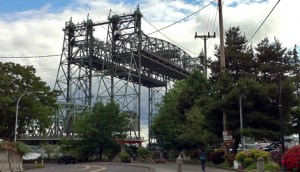 The impact of the Columbia River Crossing Light Rail project* on neighborhoods will be significant, according to CRC Environmental Manager Heather Gunderson in a presentation to the Vancouver City Council during a workshop session on June 27.
The impact of the Columbia River Crossing Light Rail project* on neighborhoods will be significant, according to CRC Environmental Manager Heather Gunderson in a presentation to the Vancouver City Council during a workshop session on June 27.
Vancouver Transportation Policy Director Thayer Rorabaugh and CRC Director Nancy Boyd joined Gunderson to discuss the CRC’s draft federal environmental impact statement to the council.
Gunderson assured the council that the impacts are not assessed in isolation and are weighed against benefits and resource trade-offs, but choices have to be made. As an example, she said the repositioning of I-5 at the “pinch-point” near where the freeway meets the river will either impact the National Historic Reserve or downtown Vancouver.
On-street parking becomes a resource trade-off, Gunderson said.
The decision for side-running light rail eliminates 422 street parking spaces, but Gunderson said the trade-off is improved north-south traffic flow, new transit access, improved overall street operations and improved bicycle and pedestrian access. She said currently 400 parking spaces are vacant during peak hours but did not mention the location of those spaces.
In addition, Gunderson said up to three intersections affected by the proposed light rail plan would be “degraded” and some driveway access points eliminated. If alternative driveway access can’t be offered to owners, then the effected property will be purchased through eminent domain.
Other issues affecting neighborhoods would be noise and vibration increases and streets would undergo a character change with the addition of light rail “down the middle.” Gunderson said because of the size of these neighborhoods a small ratio of residents would be displaced in exchange for light rail transportation, which she called “a huge benefit.”
The CRC surveyed all potentially displaced residents to determine environmental justice impacts. Environmental justice looks at the fair treatment of all people regardless of income, race or sex. “The majority are not EJ, but there are some,” Gunderson said.
The environmental justice impacts are not solely related to displacement. Gunderson identified tolling as a negative effect on low-income residents. “A toll is a higher share of their income, and that’s an impact,” especially in Washington where there are no reduced tolls, she said.
To assist low-income households, the CRC plans to help provide them with transponders, which are electronic devices that attach to a car and automatically debit the toll from a person’s checking account. If a household does not have a checking account or credit card, that becomes a barrier, but Gunderson added they have lots of examples to help secure transponders, including deducting the toll from state issued electronic benefit transfer cards.
Travelers without transponders will pay a higher rate, $1 to $1.50 more per trip, she said. Page 18 of the CRC’s Tolling Report says toll rates could range anywhere from $1.34 to $8.07 throughout the day.
Councilman Larry Smith questioned Gunderson about environmental justice for displaced businesses. He said the businesses would face the biggest challenges from construction and that could cause difficulty in supporting their families. Gunderson assured Smith that business losses would be mitigated.
Councilwoman Jeanne Stewart came to the meeting prepared to question the CRC as to why the reports neglected to include the Shumway Neighborhood, noting full and partial property lots would be made unusable there. Gunderson acknowledged the gaffe and agreed the slides be updated to reflect the project’s impact on that neighborhood.
Links to previous coverage of this workshop:
SUMMARY: CRC panel promoted the need to keep the CRC project moving, said the City Council had already endorsed light rail, and asked the council to sign the federal environmental impact statement. Council member Jeanne E. Stewart and Mayor Timothy D. Leavitt had a heated exchange when Stewart asserted the citizens should be able to vote on light rail. “The citizens have been duped into believing they would have a say if light rail proceeded,” Stewart said.
CRC Discussion Advances Past the Bridge
SUMMARY: Overview of slated light rail project’s path as it enters downtown Vancouver, improvements to Fourth Plain, the proposed elimination of the connection of West bound SR-500 to Fourth Plain, and whether further improvements that would aid the Minnehaha neighborhood can go forward. The proposed bridge structure chosen by governors of Washington and Oregon is a composite truss.
* The well-documented cost to taxpayers, if the CRC stays on budget, is $10 billion. This was established by the Cortright Report (PDF) which used data from an independent review panel hired by the governors of Washington and Oregon. (View the panel’s final report.)
See our continuing coverage of the Columbia River Crossing Light Rail project.
Do you have information to share on the CRC? To respond anonymously call 260-816-1426. To allow your comments to be used on COUV.COM call 260-816-1429.









